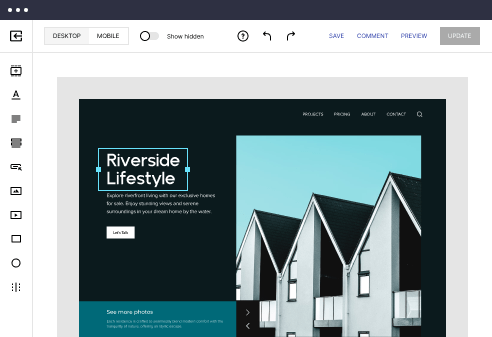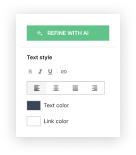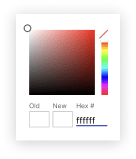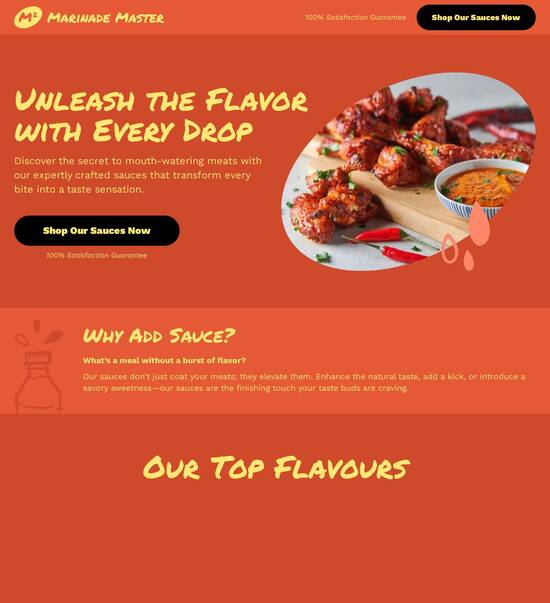
HTML5 optimized 401 unauthorized page template
Explore Similar TemplatesAbout template
Supercharge your 401 unauthorized page with HTML5 for outstanding performance! Learn more today.
Recommended templates
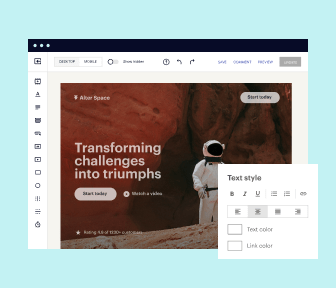
Easy to build without coding
With the intuitive drag-and-drop builder, anyone on your team can create high-converting pages without any knowledge of code or design. Make enhancements to your landing page with custom widgets using Javascript, HTML/CSS, or third-party scripts.
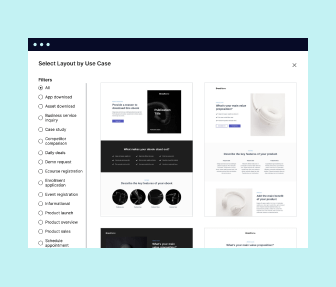
Multiple layouts for any industry and goal
Select from 500+ landing page layouts built to boost conversions across industry-specific scenarios. Customize them by adjusting fonts, adding images, and generating on-brand content with the AI assistant. Quickly scale with Instablocks® and Global Blocks that you can save, reuse, and update globally.

Loads fast and looks polished on any device
Every template is responsive, which means they present professionally on any device and load blazingly fast with our Thor Render Engine. You can also power them up with Google AMP technology to deliver an unparalleled mobile experience and drive higher conversions.
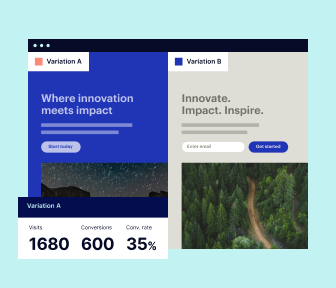
Robust analytics & experimentation
Get real-time updates and reporting across all your devices, showing the number of visitors, conversions, cost-per-visitor, and cost-per-lead. Launch AI-powered experiments, run A/B tests, and use heatmaps to analyze user behavior, then optimize your landing page to maximize conversions.
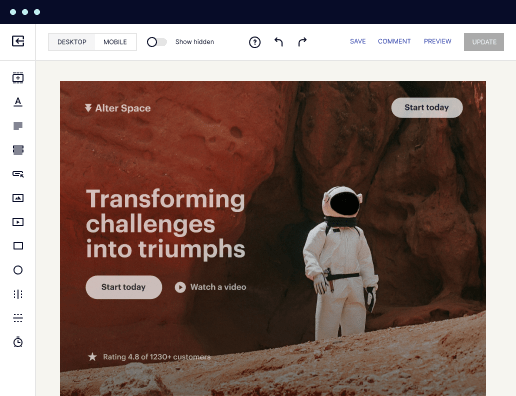
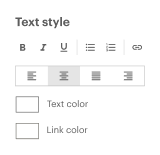
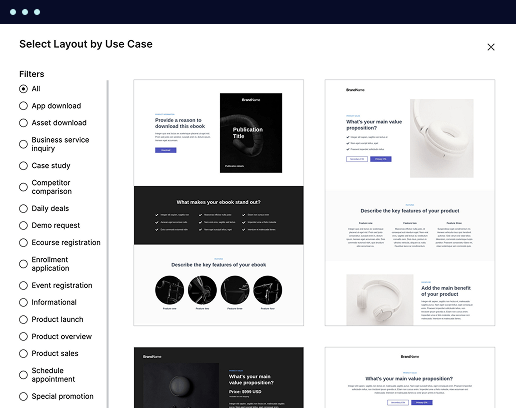


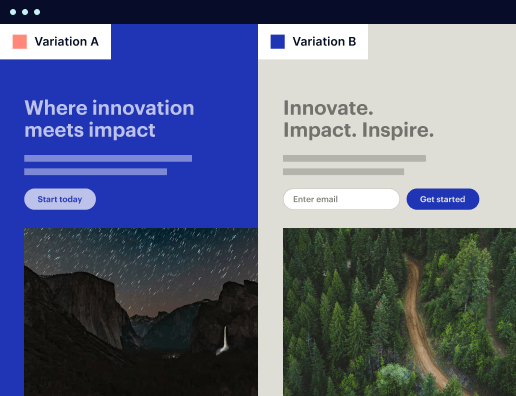
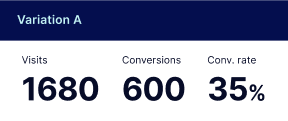
Easy to build without coding
With the intuitive drag-and-drop builder, anyone on your team can create high-converting pages without any knowledge of code or design. Make enhancements to your landing page with custom widgets using Javascript, HTML/CSS, or third-party scripts.
Multiple layouts for any industry and goal
Select from 500+ landing page layouts built to boost conversions across industry-specific scenarios. Customize them by adjusting fonts, adding images, and generating on-brand content with the AI assistant. Quickly scale with Instablocks® and Global Blocks that you can save, reuse, and update globally.
Loads fast and looks polished on any device
Every template is responsive, which means they present professionally on any device and load blazingly fast with our Thor Render Engine.
Robust analytics & experimentation
Get real-time updates and reporting across all your devices, showing the number of visitors, conversions, cost-per-visitor, and cost-per-lead. Launch AI-powered experiments, run A/B tests, and use heatmaps to analyze user behavior, then optimize your landing page to maximize conversions.
All the features you need to build lead-generating landing pages
Explore more featuresLearn how to build top-performing landing pages for any goal
FAQs
Leading the way in building high-performing landing pages





Creating a powerful landing page with Instapage
Instapage presents the ultimate solution for marketers looking to optimize their landing pages and conversion rate optimization (CRO) strategies. With its user-friendly interface and flexibility, Instapage enables businesses to craft high-converting pages that align perfectly with their marketing campaigns, regardless of their budget or team size. This guide will walk you through the essential steps to create a landing page that maximizes your marketing ROI.
Understanding landing pages
Landing pages are standalone web pages designed specifically for marketing or advertising campaigns. Unlike traditional webpages, landing pages focus on a single objective, ensuring a clear message and a compelling call to action. With Instapage, you can utilize over 100 high-converting templates tailored to various industries and marketing goals.
- Clarity of purpose: Each landing page should have a focused goal, whether it's generating leads, selling a product, or capturing email sign-ups. Clear messaging enhances user experience.
- Target audience alignment: Customizing your landing page to the needs and preferences of your target audience increases engagement and conversion rates.
- Use of persuasive elements: Incorporate testimonials, social proof, and clear benefits to compel visitors to take action.
Step 1: Selecting a template
Start by choosing one of Instapage's pre-built landing page templates that resonates with your campaign. The intuitive template selection process ensures that you find a design that fits your marketing strategy and audience expectations.
Step 2: Customizing your content
Customization is key to tailoring your landing page to your specific audience. Consider the following important aspects:
- Dynamic text replacement: Use personalizations to match the visitor's query, enhancing relatability and engagement.
- AdMaps: Align your ads with corresponding landing pages for increased consistency and relevancy, ensuring a seamless user journey.
- Call-to-action (CTA): Clearly define your CTA—whether it's 'Download Now' or 'Get Started.' Make it prominent and enticing.
Step 3: Optimize for conversions
Leveraging Instapage's built-in optimization tools is vital for continually improving your landing page performance. Use the following techniques:
- A/B testing: Experiment with different headlines, images, and CTAs to identify what resonates best with your audience.
- Heatmaps: Analyze user behavior on your landing page to see where visitors click, scroll, and spend time.
- Analytics: Regularly assess performance metrics through Instapage’s dashboard to adapt your strategies as needed.
By following these steps, you'll be well on your way to creating a high-performing landing page that aligns with your marketing initiatives and yields measurable results.
Ready to maximize your marketing efforts? Sign up with Instapage today to harness the power of effective landing pages and transform your online campaigns.
People also ask about HTML5 optimized 401 unauthorized page template
HTML5 Optimized 401 Unauthorized Page Template
Understanding the 401 unauthorized error: A brief overview
The 401 error status code indicates that the request made by the client has not been applied because it lacks valid authentication credentials for the target resource. This means that the server is telling the client that they need to authenticate themselves to obtain the requested response. Unlike the 403 Forbidden error, which implies that the server understands the request but refuses to authorize it, the 401 error signifies a lack of authentication.
The misunderstandings around the 401 error often revolve around the differences between similar status codes. 403 indicates permission issues after successful authentication, while 401 indicates that the client has not provided correct authentication or has failed to authenticate their request, making it crucial to understand the right error scenarios to address.
Authentication issues: This occurs often when required credentials are missing or invalid.
Application or production issues: Sometimes, server misconfigurations lead to unauthorized access, affecting resources.
The role of HTML5 in modern web development
HTML5 has revolutionized web development, providing newer elements and APIs that greatly enhance user experience. Moving from HTML4 to HTML5 brought myriad improvements such as semantic elements, enhanced multimedia support, and better scripting capabilities. This evolution reflects a commitment to improving how users interact with corporations and their web pages.
Key features of HTML5 contribute directly to better user experiences by allowing developers to create more dynamic, engaging webpages without needing additional plugins. Native support for audio and video, easier manipulation of graphics through the element, and a more meaningful structure with new semantic tags allow developers to craft rich content effectively.
Improved multimedia support: Native audio, video, and graphics contribute to richer content without relying on third-party plugins.
Enhanced semantics: New elements that ensure better structure and meaning for HTML documents help both users and search engines.
Designing an effective 401 unauthorized page template
Creating a well-designed 401 Unauthorized error page template must prioritize the user experience. A good error page should offer clarity and simplicity, so users can swiftly understand their situation. Essential components include clear messaging, visual hierarchy, and branding to maintain a coherent user experience.
User-centric design is crucial; the page must guide users toward resolving the issue. Integration of branding helps maintain the company’s integrity while ensuring a consistent look across different pages. This can alleviate user frustration and enhance their perception, even when they encounter an error.
User-centric design: Pages should be clear, simple, and guiding.
Visual hierarchy: Important information should stand out.
Branding integration: Reflect company identity across all error pages.
Capabilities and benefits of HTML5 optimized error pages
An HTML5 optimized error page can significantly enhance user engagement through rich content and visually engaging experiences. Instead of displaying a simple message, these pages can include meaningful instructional content that contextualizes the error for the user. Utilizing various visual elements like icons and animations can help in making the experience less frustrating and more informative.
Furthermore, analysis of user behavior on these error pages can inform improvements. By tracking bounce rates and user interactions, the development team can understand how well the messages are resonating and whether users are navigating away or seeking resolutions. This data is instrumental in continuous improvement efforts.
Rich content: Inclusion of explanations and guidance to enhance understanding.
Visual elements: Utilize icons and animations to appeal to the user visually.
Analytics: Tracking user responses helps refine navigation and improve the overall experience.
Creating an informative 401 page: Content best practices
When crafting the content for a 401 Unauthorized page, it is vital to ensure messages are clear and helpful. Avoiding technical jargon can significantly enhance communication with the user. Suggestions for wording can include friendly reminders about expected credentials or steps to resolve the issue without overwhelming technical details. Friendly tones lead to a better user experience.
Incorporating a FAQs section can also aid in addressing common user questions. This knowledge base can serve immediate needs, providing users with information on authentication issues or links to recover password functionalities. By anticipating common inquiries, businesses can better equip their users.
Clear communication: use simple language to explain the error.
Friendly tone: foster a helpful atmosphere rather than a punitive one.
FAQs: Provide prompts to answer common user questions and provide solutions.
The importance of localization in error pages
Localization plays a vital role in ensuring an effective user experience, particularly on error pages. If users encounter a 401 error, they are more likely to stay engaged if they can understand the content presented to them. Adding multilingual support allows businesses to cater to diverse audiences, implementing language detection options along with easy translation features.
Moreover, cultural sensitivity should guide the content and design elements of these error pages. For instance, the imagery and language used should reflect the customs and norms of the target audience. A culturally aware page will show respect to users, contributing positively to the brand’s image even in error situations.
Multilingual support: Implement language detection and options for translation.
Cultural sensitivity: Adapt design and content to reflect local customs and norms.
Connecting with communities to improve error handling
Engaging with other web development professionals can yield valuable insights into effective error handling practices. Developer communities, forums, and chat groups can provide a wealth of shared experiences and advice, leading to better error management strategies. This engagement can foster continuous learning and help in quickly adapting to new trends and challenges.
Utilizing online platforms for feedback can help refine how error pages are presented. Gathering direct user experiences and recommendations can inform design choices and feature functionality, ensuring that the organization appropriately addresses user concerns on 401 errors.
Engaging with communities: Share experiences and learn from collective knowledge.
Feedback platforms: Utilize various online tools to gather user insights on the effectiveness of error pages.
Techniques for collecting user feedback on error pages
Integrating feedback mechanisms directly within the 401 error page can encourage users to share their experiences. Utilizing simple forms or interactive polls can invite users to express their opinions or suggest improvements they would like to see. Example questions could range from 'Was this page helpful?' to 'What were you trying to access?'—all serving as valuable data points.
Analyzing users’ responses allows teams to synthesize feedback into actionable changes. Tracking common suggestions or complaints can guide content adjustments and enhance functionality. Case studies from businesses that effectively integrated user feedback into their error page designs illustrate the potential for improved user experiences through iteration.
Direct feedback forms: Encourage users to express their opinions directly.
Analyzing responses: Synthesize feedback to refine content and functionality.
Seamless technology integration for dynamic error pages
Incorporating backend technologies can greatly enhance the performance of HTML5 optimized 401 pages. Server-side scripting can personalize user experiences based on previous interactions or common issues. Moreover, content management systems (CMS) allow easy management and customization of error pages to fit evolving user needs.
Utilizing API calls can further enhance functionality by dynamically displaying relevant resources or support options. For example, integrating chat support directly on the error page can guide users to quickly resolve authorization issues, leading to higher satisfaction even in error situations.
Backend integration: Personalize user experiences through server-side scripting.
API calls: Enhance functionality and provide real-time support or resources.
The future of HTML5 error pages: Innovations on the horizon
As technology continues to innovate, the future of HTML5 error pages seems promising, with advancements in artificial intelligence potentially shaping user experiences. AI-driven systems may predict how users will behave after encountering a 401 error, enabling tailored interfaces that assist them more effectively. Developers might also focus on implementing future web standards to maintain compliance and optimal user experience across various devices.
In parallel, advancing web accessibility needs will remain in focus. Ensuring that every user, regardless of ability, can access clear messages and navigation is critical. Tools and frameworks supporting ADA compliance will be essential in creating all-inclusive error messaging that resonates well with diverse audiences.
Emerging technologies: AI and machine learning may enhance usability and predict user behavior.
Web accessibility: Commitment to ADA compliance, ensuring error pages are accessible to all.
Ready to skyrocket conversions?
Supercharge your ad campaigns with high-performing landing pages
Get started